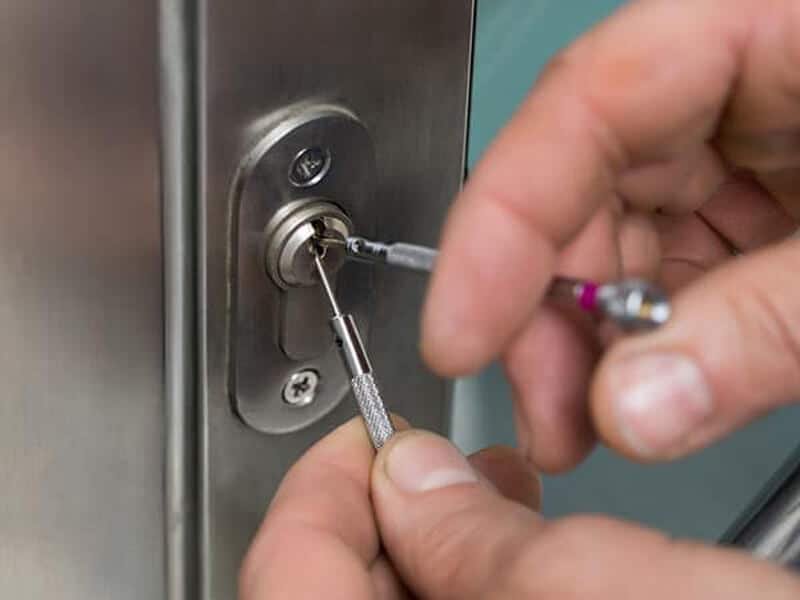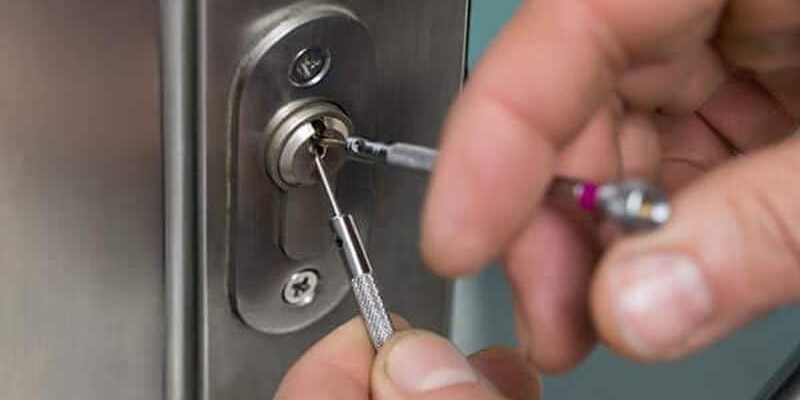
Here’s the thing: pulling a broken key from an exterior door lock isn’t about brute force. It’s more about patience, the right tools, and a steady hand. Think of it like playing Operation—you want the key out, but if you jam the tools or twist the lock, you risk making the problem so much worse (like needing a whole new lock or damaging your door). I’ll walk you through your best options, step by step, so you can handle this annoying situation safely and get back inside with as little drama as possible.
Why Keys Break In Exterior Door Locks
Keys don’t usually break off for no reason. Most of the time, there’s a little backstory—maybe the key has seen better days, or the lock has been sticky and stubborn for months. Wear and tear is a big culprit. Over time, metal keys can get bends, cracks, or weak spots, especially if you use the keyring as a handle or force it when the lock’s being a pain.
Weather is another sneaky problem. Ever tried to unlock your front door on a freezing morning? The cold can make both the lock and the key more brittle, almost inviting a break if you twist too hard. Brands like Schlage and Kwikset are built tough, but no lock is immune to the elements or plain bad luck.
Sometimes, poor fitting is to blame. If you’ve ever used a badly cut duplicate, you know how it can stick or grind inside the lock. That puts extra stress on the key, which might snap when you least expect it. Understanding why the key broke helps you avoid making the same mistake in the future and explains why patience (not force) is your best friend during extraction.
First Steps: What To Do Right After The Key Breaks
Let’s slow down here for a second. When your key breaks in the lock, every impulse screams, “Get it out right now!” But honestly, your first steps matter most. The wrong move can push the broken piece deeper, making extraction twice as tough.
First, check your situation. If the broken key is poking out at all, don’t twist or wiggle it—this can make the situation worse. Instead, gently hold the remaining piece in place, keeping everything as steady as possible. Take a look at which way the key’s teeth are facing, especially if you’ll be using tools; this helps you grip the right spots.
Next, if you have a spare key or another way in, use it now. There’s no shame in taking a breather and getting proper tools instead of forcing things in the cold or dark. If you have a universal key extractor set, get it ready. But if you don’t—even a pair of tweezers, needle-nose pliers, or a sturdy paperclip can do the trick in a pinch. Just avoid pushing the broken piece further inside the lock.
Pro tip: If you can, spray a tiny bit of graphite powder or lock lubricant into the lock before trying anything else. This can help loosen things up, making extraction much easier.
Best DIY Methods To Extract A Broken Key
If you’re set on a do-it-yourself approach, you’ve got a few time-tested options to try. Each method works best in different scenarios, depending on how much of the broken key is sticking out and what tools you have on hand.
- Tweezers or Pliers: If a piece of the key is sticking out, grab onto it firmly with tweezers or narrow needle-nose pliers. Gently pull straight out—don’t twist—as twisting can jam the fragments deeper.
- Paperclip or Pin: If nothing is sticking out, straighten a sturdy paperclip or bobby pin. Slide it alongside the key fragment—try to hook the teeth on the broken key and ease it out. Patience is critical—move slowly and don’t force anything.
- Broken Key Extractor Tool: These thin, hook-like tools are designed for exactly this job. Slide the extractor along the key fragment (on the groove side if possible). Hook the end behind the broken piece, then carefully pull outward. Most hardware stores carry basic sets, and they work on most lock brands like Schlage, Kwikset, and Yale.
Try to keep the lock in the “neutral” position (not turned). If you turned the key before it broke, try turning it back gently with a flat screwdriver before extraction. This lines up the pins inside the lock, making removal easier.
When To Use Lubrication Or Cooling
You might be wondering, “Does it really help to spray stuff into the lock?” The answer is, yes—sometimes a little lubrication is the difference between a quick fix and hours of frustration. Lock lubricants like graphite powder work best, but WD-40 can also help in a pinch.
Here’s how to use it: Lightly spray lubricant into the keyway, aiming to coat the metal around the broken key piece. Wait a minute or two, then try your extraction method again. The slippery surface helps the key piece slide out instead of snagging or breaking further. Just don’t overdo it—too much spray can gum up the inside.
In winter, extreme cold can also be a help or a hindrance. If the metal’s contracted from the cold, it might be gripping the key even tighter. Warming the area gently with your hands or a hair dryer can expand the metal slightly and loosen the grip (never use open flames near your door). On rare occasions, cooling the area with ice can shrink the broken piece and help it slip out, but that’s usually only useful for locks stuck in hot environments.
Why Professional Locksmiths Succeed Where DIY Fails
Sometimes, despite your best efforts, that broken key just won’t budge. Maybe the fragment is deep inside, or you’ve tried tweezers and extractors with no luck. Here’s where calling a professional locksmith really pays off.
Locksmiths have specialized extraction tools and years of experience with all sorts of brands—Schlage, Yale, Kwikset, you name it. They can see inside the lock, use tiny picks and extractors, and even reset the pins if something gets jammed. They also know how to avoid damaging the lock, which can save you the cost of a full replacement.
Honestly, it’s not about giving up—it’s about avoiding a bigger problem. If you’ve tried all your options and the key is still stuck, forcing it can break the lock cylinder, damage your door, or even snap the extractor tool. A pro can often fix things in ten minutes, saving you from bigger repairs or a full lock replacement.
How To Prevent Broken Keys In The Future
After dealing with a broken key once, most people never want to repeat the experience. Luckily, there are a few simple habits that can help you avoid another snap-off in the future.
- Check your keys regularly for cracks, bends, or thinning areas. If one looks worn out, get a new copy made before it breaks off in the lock.
- Keep your locks clean and lubricated. A quick spray of graphite powder every few months can keep the pins moving smoothly. This is especially important for exterior locks exposed to rain, dust, or freezing temperatures.
- Don’t force the key if your lock is sticky or hard to turn. Instead, spray a lubricant and gently wiggle the key. If problems continue, it’s time for lock troubleshooting or calling a locksmith.
- Use the right key for each lock, and avoid overloading your key ring. Heavy keychains put extra pressure on key blades, wearing them out faster than you’d think.
Schlage, Kwikset, and other major brands design keys for durability, but even the toughest metal wears down eventually. Taking care of your keys and locks is quick insurance against future headaches.
Alternatives: When Replacement Makes More Sense
Let me explain why sometimes the best way forward is a fresh start. If your key is hopelessly buried, your lock is old or unreliable, or you’ve already tried multiple extraction methods without success—a new lock or cylinder might be the smarter move.
Replacement usually makes sense if:
- The lock is damaged, jammed, or unreliable even after key removal
- You’ve lost faith in the lock (maybe it’s been picked, forced, or tampered with before)
- You want to upgrade to a more secure or modern system (like a smart lock or keypad entry)
The good news? Swapping out a standard Schlage or Kwikset deadbolt isn’t hard—most are designed for quick replacement. You just need a screwdriver and a little patience. Universal kits often work if your existing lock brand isn’t available. Just remember to pair and reset any smart features if your lock is electronic, and always test the new key before closing your door for the night.
What To Do If The Door Won’t Open After Extraction
Sometimes, you get the broken key out, but the lock still won’t budge. Maybe some debris is still jammed inside, or the pins are stuck. Here’s what to try next.
First, shine a flashlight into the keyhole and check for leftover fragments. Use a thin piece of wire or a blast of compressed air to clear out any bits. If the lock is still stubborn, try lubricating it again and gently inserting your spare key, wiggling back and forth to reset the pins.
In rare cases, resetting the lock’s code or pairing process (for smart locks) can help, especially if the mechanism got confused or stuck during the key drama. If nothing works, you might have a deeper mechanical problem inside the lock, and calling a locksmith is your safest option.
Remember: Trying to force the door open at this stage usually leads to bigger problems, including broken hardware, frame damage, and even injuries.
Dealing with a broken key in an exterior door lock is no one’s idea of fun, but it’s a fixable problem—especially if you keep your cool and follow the right steps. Whether you’re working with a trusty Schlage, reliable Kwikset, or another major lock, the best way forward is slow, steady, and careful. From using tweezers and extractors to knowing when it’s time to call in the pros, you have options at every step. The best advice? Take your time—forcing things almost always makes it worse. With a little patience (and maybe a quick trip to the hardware store), you’ll have your door open and your sense of calm restored in no time.
